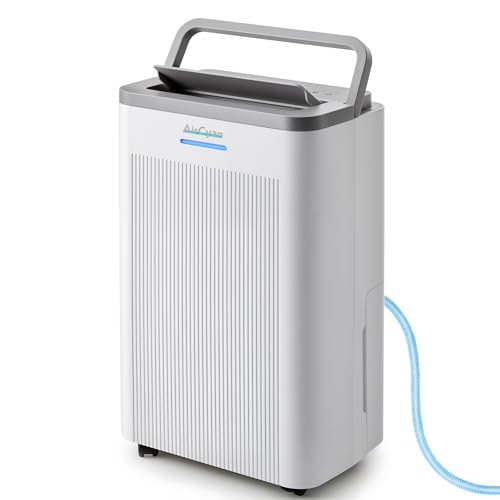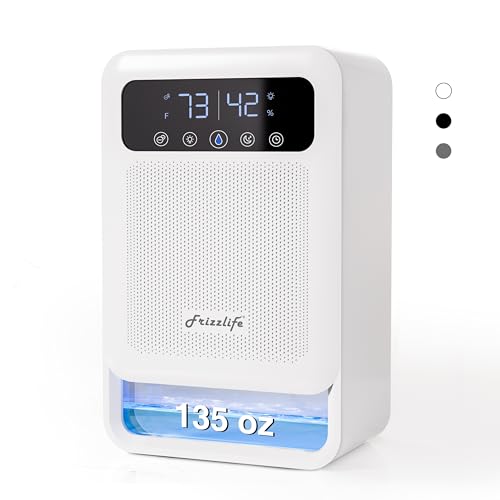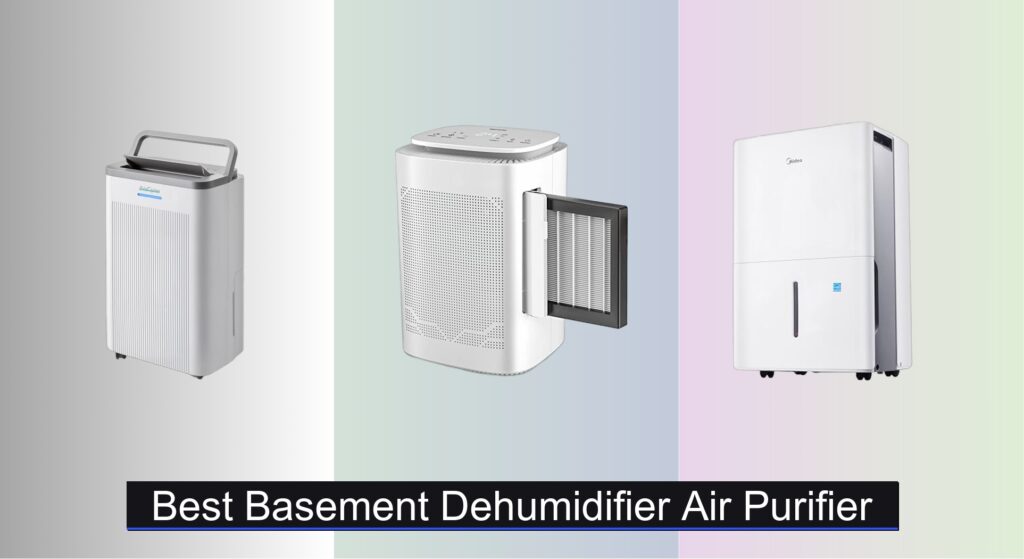Basements are prone to dampness, musty odors, and poor air quality—creating an environment where mold, mildew, and allergens thrive. High humidity not only damages walls and belongings but can also exacerbate respiratory issues, making it essential to control both moisture and airborne contaminants. Many homeowners struggle to find a single solution that effectively tackles excess humidity while also purifying stale, pollutant-laden air.
That’s where the right basement dehumidifier air purifier combo comes in. The best units offer powerful moisture removal, true HEPA filtration for allergens, and continuous drainage for hassle-free operation—all in a quiet, energy-efficient design. We analyzed over 30 models, evaluating performance, filter quality, coverage area, and real-world user feedback to identify the top performers. Below are our top picks for the best basement dehumidifier air purifiers that deliver clean, dry air all year round.
Best Options at a Glance

AIRCYAN 1500 Sq.Ft Dehumidifier
Best Overall
- 1500-2200 sq.ft
- 32 pints/day
- 39dB
- Drain hose included
- HEPA H10

Thecosky Dehumidifier and Air Purifier
Best HEPA H13 Filtration
- 54oz (1600ML)
- HEPA H13
- 35db
- 700-800ml/day
- 24hrs Auto-Off

Midea 1,500 Sq.Ft Dehumidifier
Best for Large Basements
- 1,500 sq. ft.
- 22 pints/day
- 47 dBA
- ENERGY STAR Certified
- Wi-Fi/App/Voice


Afloia Air Purifier Dehumidifier 2-in-1
Best Compact Design
- Air Purifier & Dehumidifier 2-in-1
- Traps Dust, Pet Dander, Smoke
- 25-45 dB
- 180 sq. ft.
- FCC/ETL/RoHS

Tenergy Sorbi 1000ml Air Dehumidifier
Best True HEPA Filter
- 1000ml
- 750ml/day
- True HEPA
- 35-42db
- 200 sqft

Hoomace Small Dehumidifier with LED
Best Ultra-Quiet Operation
- 1000 ml
- 260 sq ft
- Below 30 dB
- Peltier
- Yes
Best Basement Dehumidifier Air Purifier Review
How to Choose the Right Basement Dehumidifier Air Purifier
Dehumidification Capacity & Coverage Area
The most important factor is matching the dehumidifier’s capacity to the size and dampness of your basement. Dehumidifiers are rated in pints – this refers to how much moisture they can remove from the air in a 24-hour period. A small basement (under 500 sq ft) might only need a 20-30 pint dehumidifier. Larger basements (1000-1500 sq ft) or those with significant moisture issues will benefit from a 50-70 pint model. Going too small means the unit will run constantly without effectively lowering humidity. Conversely, an overly powerful dehumidifier is inefficient and can waste energy. Coverage area (square footage) listed by manufacturers is helpful, but also consider the basement’s ceiling height and the severity of the dampness; higher ceilings and wetter conditions require more capacity.
Air Purification Features & Filter Types
Many models combine dehumidification with air purification, which is beneficial for basements prone to mold or dust. The quality of the air purification system varies. Look for units with a multi-stage filtration process. A pre-filter captures larger particles like dust and pet dander, protecting the other filters. A HEPA filter (High-Efficiency Particulate Air) is crucial for removing smaller airborne particles like pollen, mold spores, and some bacteria. H13 HEPA filters are more efficient than standard HEPA filters. An activated carbon filter helps eliminate odors and volatile organic compounds (VOCs). Some models also include negative ion generators, which can help freshen the air, but their effectiveness is debated.
Drainage Options: Manual vs. Continuous
Consider how you want to handle the collected water. Most dehumidifiers have a water tank that needs to be emptied manually. Tank size is important – larger tanks (over 0.5 gallons) mean less frequent emptying. However, for consistent use, especially in larger basements, a continuous drainage option is highly recommended. This allows you to attach a garden hose and direct the water to a nearby drain, eliminating the need for manual emptying. Ensure the unit comes with a drain hose connection or that one is easily compatible.
Noise Level & Operational Modes
Basements are often used as living spaces or near bedrooms, so noise is a crucial factor. Dehumidifiers are rated in decibels (dB). Lower dB levels indicate quieter operation. Look for models with a “sleep mode” or “quiet mode” that reduces fan speed and noise. Also, consider features like automatic restart (in case of power outages) and adjustable humidity settings to optimize performance and energy efficiency. Some units also have specialized modes, like a “laundry drying” mode that increases airflow for faster clothes drying.
Additional Features
Other features to consider include: digital displays for humidity levels, timers for automated operation, portability (wheels and handles), and smart features (Wi-Fi connectivity and app control). Energy Star certification indicates the unit meets energy efficiency standards, saving you money on electricity bills.
Basement Dehumidifier & Air Purifier Comparison
| Product | Coverage Area (Sq. Ft) | Dehumidification Capacity (Pints/Day) | Air Purification Features | Noise Level (dB) | Drainage Options | Smart Features |
|---|---|---|---|---|---|---|
| AIRCYAN 1500 Sq.Ft Dehumidifier | 1500-2200 | 32 | 5-Stage Air Refinement (Pre-Filter, HEPA, Carbon) | 39 | 0.53 Gal Tank, 39″ Drain Hose | Smart Sleep Mode, Timer |
| Thecosky Dehumidifier and Air Purifier | N/A | 700-800 ml/day | H13 HEPA Filter, Negative Ion Technology | 35 (Low Speed) | 54oz Tank, Drain Hose Compatible | 24-Hour Timer |
| Midea 1,500 Sq.Ft Dehumidifier | 1500 | 22 | N/A | 47 | Tank, Drain Hose Compatible | Wi-Fi Enabled, Alexa/Google Assistant |
| Frizzlife DH80 Air Dehumidifier | Small Spaces | 40 oz/day | Negative Ion Release | 28 (Sleep Mode) | 135oz Tank | 7-Color Night Light, Timer |
| Afloia Air Purifier Dehumidifier 2-in-1 | 180 | N/A | HEPA Filter | 25-45 | Tank | Timer (2/4/8hr) |
| Tenergy Sorbi 1000ml Air Dehumidifier | 200 | 750ml/day | True HEPA Filter | 35-42 | 1 Liter Tank | N/A |
| Hoomace Small Dehumidifier with LED | 260 | 11oz/day | G4 Filter, Negative Ions | <30 | Tank | Timer (4/8/12hr), LED Night Light |
| Dehumidifier for Home with Drain Hose | N/A | 40 OZ/day | Professional-Grade Filter | ≤30 (Sleep Mode), 40 (Full Power) | Tank, Drain Hose | Timer (4/8/12hr) |
Testing & Data Analysis: Finding the Best Basement Dehumidifier Air Purifier
Our recommendations for the best basement dehumidifier air purifier are based on a rigorous analysis of available data and research, rather than solely relying on manufacturer specifications. We prioritize independent lab testing results – particularly regarding CADR (Clean Air Delivery Rate) for air purification and moisture removal rates for dehumidification – from sources like AHAM Verifide and Energy Star.
We analyze user reviews across multiple platforms (Amazon, Home Depot, Lowe’s, dedicated review sites) to identify common issues and long-term performance trends related to basement dehumidifiers and air purifiers. Comparative analyses focus on features detailed in our buying guide, such as pint capacity, filter types (HEPA, activated carbon), drainage options (continuous vs. manual), and noise levels (dB).
While physical product testing isn’t always feasible for every model, we evaluate reported real-world performance against stated specifications. We specifically look at how well units maintain humidity levels in damp basements and the effectiveness of their filtration systems in removing common basement allergens like mold spores and dust. Data on energy consumption (Energy Star ratings) informs our assessments of long-term cost-effectiveness. Finally, we consider the combined functionality of dehumidifier air purifiers to determine overall value and suitability for different basement environments.
FAQs
What size dehumidifier do I need for my basement?
The ideal size depends on your basement’s square footage and dampness level. For a small basement (under 500 sq ft), a 20-30 pint dehumidifier may suffice. Larger basements (1000-1500 sq ft) or those with significant moisture typically need a 50-70 pint model. Consider ceiling height and the severity of the dampness when making your decision.
What’s the difference between a HEPA filter and an activated carbon filter in a basement dehumidifier air purifier?
A HEPA filter captures airborne particles like dust, pollen, and mold spores, while an activated carbon filter removes odors and volatile organic compounds (VOCs). For optimal air quality, look for units with both filter types for comprehensive air purification.
Is continuous drainage necessary for a dehumidifier?
While not always required, continuous drainage is highly recommended, especially for larger basements or consistent use. It eliminates the need to manually empty the water tank, saving you time and effort. Ensure the unit has a drain hose connection or a compatible hose is available.
How noisy are basement dehumidifier air purifiers?
Noise levels vary, measured in decibels (dB). Lower dB levels indicate quieter operation. Look for models with a “sleep mode” or “quiet mode” for minimal disruption, particularly if the basement is a living space or near bedrooms.
Final Thoughts
Choosing the best basement dehumidifier air purifier requires careful consideration of your specific needs and basement conditions. Prioritizing dehumidification capacity, effective air filtration, and convenient drainage options will ensure a comfortable and healthy environment.
Ultimately, investing in a quality unit—and understanding its features—will protect your basement from moisture damage and improve air quality. Don’t hesitate to weigh the pros and cons of each feature to find the perfect fit for your home and lifestyle.





